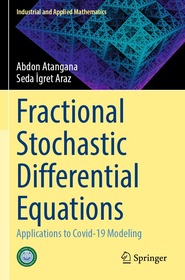
Fractional Stochastic Differential Equations
Applications to Covid-19 Modeling
Sorozatcím: Industrial and Applied Mathematics;
-
20% KEDVEZMÉNY?
- A kedvezmény csak az 'Értesítés a kedvenc témákról' hírlevelünk címzettjeinek rendeléseire érvényes.
- Kiadói listaár EUR 160.49
-
66 563 Ft (63 393 Ft + 5% áfa)
Az ár azért becsült, mert a rendelés pillanatában nem lehet pontosan tudni, hogy a beérkezéskor milyen lesz a forint árfolyama az adott termék eredeti devizájához képest. Ha a forint romlana, kissé többet, ha javulna, kissé kevesebbet kell majd fizetnie.
- Kedvezmény(ek) 20% (cc. 13 313 Ft off)
- Kedvezményes ár 53 250 Ft (50 714 Ft + 5% áfa)
Iratkozzon fel most és részesüljön kedvezőbb árainkból!
Feliratkozom
66 563 Ft

Beszerezhetőség
Megrendelésre a kiadó utánnyomja a könyvet. Rendelhető, de a szokásosnál kicsit lassabban érkezik meg.
Why don't you give exact delivery time?
A beszerzés időigényét az eddigi tapasztalatokra alapozva adjuk meg. Azért becsült, mert a terméket külföldről hozzuk be, így a kiadó kiszolgálásának pillanatnyi gyorsaságától is függ. A megadottnál gyorsabb és lassabb szállítás is elképzelhető, de mindent megteszünk, hogy Ön a lehető leghamarabb jusson hozzá a termékhez.
A termék adatai:
- Kiadás sorszáma 1st ed. 2022
- Kiadó Springer Nature Singapore
- Megjelenés dátuma 2023. április 23.
- Kötetek száma 1 pieces, Book
- ISBN 9789811907319
- Kötéstípus Puhakötés
- Lásd még 9789811907289
- Terjedelem540 oldal
- Méret 235x155 mm
- Súly 842 g
- Nyelv angol
- Illusztrációk XV, 540 p. 162 illus. in color. Illustrations, color 456
Kategóriák
Hosszú leírás:
This book provides a thorough conversation on the underpinnings of Covid-19 spread modelling by using stochastics nonlocal differential and integral operators with singular and non-singular kernels. The book presents the dynamic of Covid-19 spread behaviour worldwide. It is noticed that the spread dynamic followed process with nonlocal behaviours which resemble power law, fading memory, crossover and stochastic behaviours. Fractional stochastic differential equations are therefore used to model spread behaviours in different parts of the worlds. The content coverage includes brief history of Covid-19 spread worldwide from December 2019 to September 2021, followed by statistical analysis of collected data for infected, death and recovery classes.
Több



